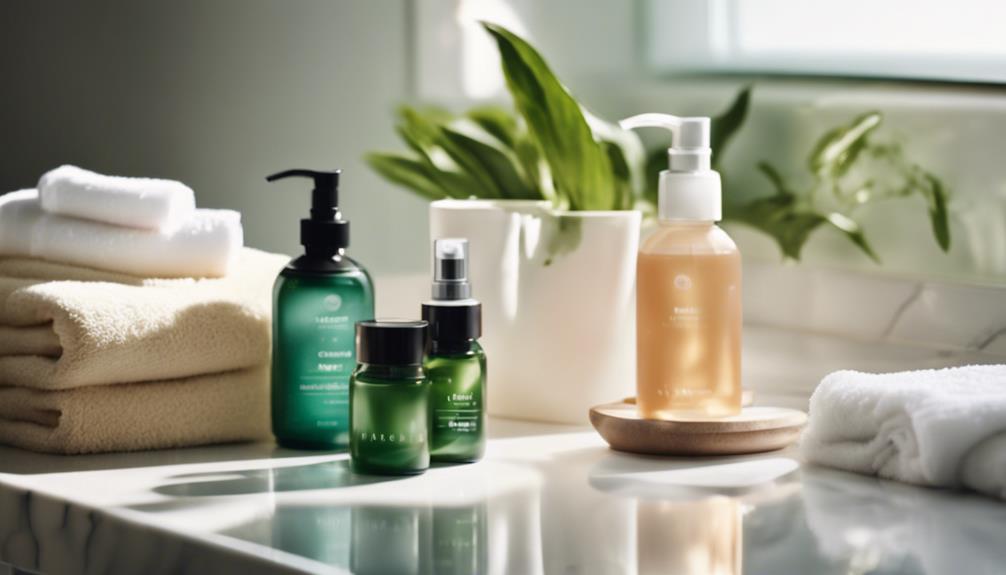If you have dry skin, maintaining a solid hydration routine is essential. To start your day, use a gentle cleanser followed by a hydrating toner. Then, apply a serum containing hyaluronic acid or ceramides, and finish with a rich moisturizer to lock in moisture. In the evening, cleanse with an oil-based cleanser and repeat the hydration routine, adding a night cream to seal in moisture. Remember to use sunscreen daily to protect your skin and keep it hydrated. Using a humidifier and staying well-hydrated will enhance your results. There are many more options to explore to achieve optimal hydration for your skin.
Key Takeaways
- Use a gentle, moisturizing cleanser and follow with a hydrating toner to prepare skin for further hydration.
- Incorporate serums with hyaluronic acid and niacinamide to enhance moisture retention and repair the skin barrier.
- Apply a rich moisturizer containing occlusives like shea butter to lock in hydration after other products.
- Include daily broad-spectrum sunscreen to protect the moisture barrier and prevent UV-induced aging signs.
Understanding Dry Skin
Dry skin, or xerosis, occurs when your skin loses moisture, leading to flakiness, tightness, and sometimes itching. This condition often arises due to a compromised moisture barrier, which can be affected by various environmental factors like cold weather, low humidity, and central heating. When your skin barrier weakens, it struggles to retain hydration, causing increased sensitivity and irritation.
To combat dry skin, focus on restoring your skin's moisture barrier. Ingredients like hyaluronic acid and glycerin are essential, as they draw water into the skin and keep it hydrated. Regularly applying these ingredients can help improve your skin's overall texture and reduce flakiness.
It's important to recognize that some individuals may experience seasonal dryness, while others have a year-round dry skin type influenced by genetic and hormonal factors. Understanding the reasons behind your dry skin can empower you to take the right steps toward relief.
Prioritize hydration in your routine, and choose products that support your skin barrier to minimize irritation and enhance your skin's resilience against external stressors.
Morning Skincare Steps

Start your morning skincare routine with a gentle, moisturizing cleanser that hydrates your skin without stripping away its natural oils. Look for a gentle cleanser containing glycerin and hyaluronic acid to effectively cleanse while maintaining moisture.
Next, apply an alcohol-free toner infused with hydrating ingredients like vitamin E and aloe. This step prepares your skin for better absorption of moisture.
After toning, incorporate a serum enriched with hyaluronic acid, niacinamide, or ceramides. These ingredients boost hydration and help strengthen your skin barrier.
Once the serum has absorbed, reach for a rich moisturizer. Verify it contains occlusives like shea butter or squalane to lock in that precious hydration throughout the day. This is vital for keeping your skin soft and supple.
Nighttime Skincare Steps

Begin your nighttime skincare routine with a gentle oil or gel cleanser that effectively removes makeup and impurities while preserving your skin's moisture barrier.
This step is essential for preventing water loss and preparing your skin for the rest of your routine.
Next, apply a hydrating toner that contains ingredients like glycerin or hyaluronic acid.
This will boost moisture levels before you move on to a hydrating serum.
Choose a serum with niacinamide; it aids in skin repair and enhances hydration.
For best absorption, apply this serum to damp skin.
Once your serum has settled, it's time to moisturize.
Use a rich night cream that includes occlusives like shea butter to seal in hydration and prevent water loss overnight.
If you want to enhance your routine further, consider incorporating retinol 1-2 times a week after cleansing.
Just make sure you pair it with your hydrating serum to mitigate potential dryness.
This careful layering will help your skin recover and thrive while you sleep, leaving you refreshed and ready for the day ahead.
Essential Hydrating Ingredients

When it comes to keeping your skin hydrated, knowing the essential ingredients is key.
You'll want to understand the difference between humectants and occlusives, and how they work together to lock in moisture.
Let's explore some of the most effective moisturizing components that can transform your dry skincare routine.
Key Moisturizing Components
Understanding the key moisturizing components is essential for achieving ideal hydration in your skincare routine. Incorporating ingredients like Hyaluronic Acid can dramatically enhance hydration, as it holds up to 1,000 times its weight in water. This powerful humectant attracts moisture, keeping your skin plump and hydrated.
Ceramides play a vital role as well; these lipid molecules restore and maintain your skin's moisture barrier, protecting it from environmental irritants and preventing moisture loss.
Glycerin is another potent humectant, drawing moisture from the air and improving both hydration levels and skin texture.
Don't overlook Niacinamide, or Vitamin B3. It not only hydrates but also strengthens your skin's barrier function, promoting better moisture retention and a more even tone.
Incorporating fatty acids from oils like argan and jojoba can enhance your skin's hydration too. These fatty acids create a protective barrier, reducing water loss and improving overall moisture levels.
Humectants Vs. Occlusives
Humectants and occlusives work hand in hand to provide essential hydration, each playing a unique role in maintaining your skin's moisture balance.
Humectants, like hyaluronic acid and glycerin, attract water from the environment and deeper skin layers, enhancing hydration levels. This makes them critical for keeping your skin moist and plump.
On the other hand, occlusives, such as petrolatum, beeswax, and shea butter, create a protective barrier on your skin's surface that prevents water loss, sealing in moisture for long-lasting hydration.
To optimize your skincare routine, it's best to combine both humectants and occlusives. Apply humectants on damp skin to draw moisture in, then layer occlusives on top to lock it in. This synergistic approach greatly improves skin hydration and skin barrier function, leading to a smoother and more resilient complexion over time.
For maximum effectiveness, remember that using these moisturizing ingredients together is key. By understanding the roles of humectants and occlusives, you can guarantee your skin remains hydrated throughout the day, making dryness a thing of the past.
Importance of Sunscreen

Using sunscreen is vital for preventing skin damage and reducing signs of aging.
By applying it daily, you protect your skin from harmful UV rays that can lead to premature wrinkles and other issues.
Don't underestimate the power of sunscreen in your dry skincare routine; it's essential for maintaining healthy, youthful skin.
Prevents Skin Damage
Sunscreen is your best defense against skin damage and premature aging, making daily application vital for maintaining healthy skin. Even on cloudy days, up to 80% of UV rays can penetrate, so you need to protect your skin consistently. A broad-spectrum sunscreen with at least SPF 30 is essential in safeguarding your moisture barrier, especially if you have dry skin.
Here's a quick guide to help you choose the right sunscreen:
| Type of Sunscreen | Benefits | Recommendations |
|---|---|---|
| Mineral | Less irritating for sensitive skin | Zinc oxide or titanium dioxide |
| Chemical | Lightweight and easy to apply | Look for broad-spectrum options |
| Hybrid | Combines benefits of both | Offers broad-spectrum protection |
Using sunscreen rich in soothing ingredients can further help hydrate your skin. Remember to reapply every two hours, particularly after sweating or swimming, to maintain effective protection. Incorporate this essential step into your dry skincare routine to guarantee your skin stays healthy and youthful. Protecting your skin from UV rays is a key part of keeping it hydrated and preventing long-term damage.
Reduces Aging Signs
Daily application of broad-spectrum sunscreen is important to greatly reduce visible signs of aging, like fine lines and wrinkles.
UV exposure can cause up to 80% of these aging signs, leading to premature skin damage. To combat this, you should incorporate a broad-spectrum sunscreen with an SPF of 30 or higher into your skincare routine, ensuring you shield your skin from harmful rays.
Consistent use of sunscreen helps maintain your skin's hydration and protects the moisture barrier, which is essential for preserving skin elasticity.
When you apply sunscreen daily, even on cloudy days or when indoors, you prevent the breakdown of collagen—an important protein that keeps your skin firm and elastic. Remember, up to 80% of UV rays can penetrate through clouds and windows, so don't skip this crucial step.
To maximize its effectiveness, reapply your sunscreen every two hours, especially after swimming or sweating.
By committing to this habit, you'll not only reduce the appearance of fine lines but also promote a healthier, more youthful complexion in the long run.
Protect your skin today to enjoy its beauty tomorrow!
Exfoliation Techniques

Exfoliating your skin regularly can considerably enhance its texture and glow, especially if you have dry skin that tends to flake and appear dull. For dry skin types, chemical exfoliants, particularly alpha hydroxy acids (AHAs) like glycolic acid, are your best bet. They gently remove dead skin cells without causing irritation or micro-tears, unlike physical scrubs.
Aim to exfoliate once or twice a week to avoid over-exfoliation, which can lead to increased sensitivity and dryness. Look for products that incorporate hydrating ingredients, such as hyaluronic acid, to help maintain moisture levels while effectively exfoliating. This way, you're not just sloughing off dead skin but also supporting your skin's hydration.
After exfoliation, it's essential to apply a rich moisturizer to replenish hydration and reinforce your skin barrier, which may be compromised after exfoliating. This combination of exfoliation and hydration is key to achieving a smoother, more radiant complexion.
Additional Hydration Tips

Incorporating a humidifier into your home can greatly boost moisture levels in the air, helping to combat skin dryness, especially during the colder months.
Alongside this, maintaining adequate water intake is essential; aim for at least 8 glasses daily to support overall skin hydration. When you apply moisturizer right after bathing, while your skin is still damp, you enhance product absorption, locking in important moisture.
Don't forget about exfoliation! Using a gentle exfoliant, like glycolic acid, 1-2 times a week can help remove dead skin cells. This not only improves skin texture but also allows for better absorption of your moisturizer.
Additionally, wearing protective clothing can shield your skin from harsh environmental factors that contribute to dryness. When heading outdoors, always apply sunscreen with SPF 30 or higher to guard against UV damage, which can further exacerbate skin issues.
What Are Some Tips for Hydrating Dry Skin in a Skincare Routine?
If you have dry skin, consider these hydrating skincare routine tips. Firstly, use a gentle cleanser to avoid stripping natural oils. Incorporate a rich moisturizer with hyaluronic acid to lock in moisture. Don’t forget to hydrate from within by drinking plenty of water and using a humidifier.
Conclusion
In embracing a consistent dry skincare routine, you're not just treating your skin; you're nurturing your confidence and well-being.
Remember, hydration isn't just a step—it's a ritual that transforms how you feel in your own skin.
By incorporating these tips and ingredients, you're crafting a protective barrier against dryness that will leave you glowing.
So, why settle for anything less than radiant skin?
Your journey to hydration starts now, and every drop counts.









